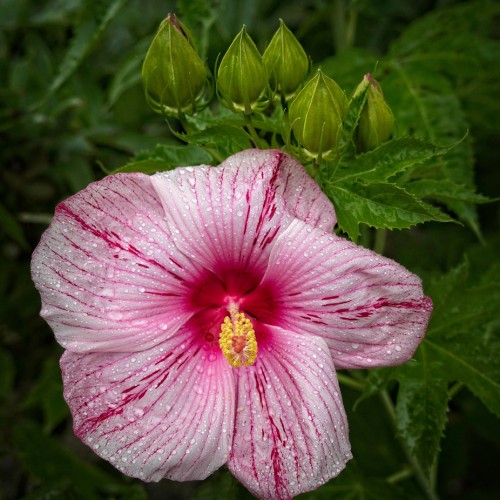
hardy hibiscus
Hibiscus 'Plum Crazy'
Cycle:
Herbaceous Perennial
Watering:
Frequent
Hardiness Zone:
4 - 9
Flowers:
Flowers
Sun:
Full sun
Leaf:
Yes
Growth Rate:
High
Maintenance:
Low
Care Level:
Medium
watering
Hardy hibiscus (Hibiscus 'Plum Crazy') should be watered regularly to ensure it is healthy and blooms. Water these plants deeply at least once a week during the growing season (spring through fall), but be prepared to water more often during dry spells and hot summer days. Check the soil periodically for moisture—water when the top 2 inches of soil feels dry. Avoid over-watering, as the plant's roots will rot if left in soggy soil. If possible, use a drip irrigation system to evenly distribute water or a soaker hose, which slowly seeps moisture to the roots. During winter months, water sparingly, allowing the soil to dry out almost completely before the next watering.
sunlight
Hardy hibiscus (Hibiscus 'Plum Crazy') thrive with plenty of sunlight. They should be planted in a location where the plant will receive at least 6 to 8 hours of direct sunlight each day. Early morning sunlight is especially beneficial, and the plant does best when located in an area protected from strong winds. During the peak of summer, some afternoon shade is beneficial to help keep the plant from getting too hot.
pruning
When it comes to pruning a Hardy Hibiscus plant, you should wait until late winter or early spring when the plant has gone dormant. This is the best time to do pruning as it helps the plant to stay healthy and flower abundantly. When pruning, you should removed any winter damage done to the plant such as dead foliage and dead and weak branches. This will help keep the plant healthy and encourage healthy growth. Additionally, try to remove any diseased or insect damaged branches, as well as old stems and shoots that have bloomed and are now dead. When it comes to how much to prune, it is best to err on the side of caution. You should be careful not to remove too many branches each year, as this can leave the plant vulnerable to pests and disease, as well as looking bare and unwelcome. It is best to prune branches that are diseased, dead, weak, or overcrowded. Pruning just a third of the plant each year should be sufficient.
